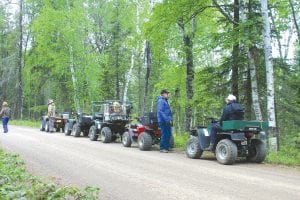A process begun in 2006 to create a travel management plan (TMP) to designate which forest roads and trails will be open to cars, trucks and off-highway vehicles in the Superior National Forest may be closer to becoming a reality—unless the three environmental groups opposed to the plan once again seek to overturn the Forest Service plan in the courts.
On April 12, 2012, U.S. District Judge Susan Richard Nelson awarded summary judgment to the U.S. Forest Service, giving it the go-ahead to proceed with its travel management plan. Judge Richard Nelson rejected the claims of the Minnesota Center for Environmental Advocacy (MCEA), the Sierra Club and Northeastern Minnesotans for Wilderness (NMW) that implementing the travel management plan and allowing off-highway vehicles in the Superior National Forest would degrade the wilderness character of the Boundary Waters Canoe Area Wilderness.
Contacted on April 16, Superior National Forest Gunflint District Ranger Dennis Neitzke said his office had heard about the ruling on April 13. He said, “We’ve already started talking about how to implement it. It takes publishing our motorized vehicle use map. We had that prepared a couple years ago, but now we need to update it.”
However, Neitzke cautioned, “There is a chance they’ll take this to appeals court.”
The groups have 60 days to appeal.
Such an appeal would be the latest in a long string of efforts aimed at halting the Forest Service Superior National Forest travel management plan. When the plan was completed in 2008—after two years of Forest Service collaboration with Minnesota Department of Natural Resources (DNR), Cook, Lake, and St. Louis county officials, and representatives of the Grand Portage Band of Lake Superior and public input—the Minnesota Center for Environmental Advocacy (MCEA) filed an administrative appeal to the regional Forest Service office in Milwaukee.
The Forest Service Region 9 appeal deciding officer in Milwaukee upheld the local decision in March 2009, stating that “consolidating OHV [off-highway vehicle] use is expected to, over the long run, result in lower road maintenance costs, cleaner water, improved wildlife and fish habitat, and fewer conflicts between motorized and non-motorized recreationists.”
MCEA and the other environmental groups filed suit in May 2010 claiming that the Forest Service plan violated the Endangered Species Act (ESA) by threatening the Canada lynx. The MCEA also claimed that Forest Service had not adequately considered the impact to the BWCAW.
Judge Richard Nelson rejected the environmental groups’ claims that increased OHV traffic would harm the Canada lynx, noting that the overall project decreases the number of roads and trails open to OHVs. She also rejected the call from the plaintiffs for an environmental impact study, which they asserted were necessary because of “noise, water pollution, air pollution and other impacts that will clearly change the nature of the wilderness experience.”
Judge Richard Nelson said the plaintiff ’s arguments did not “establish undisputed facts,” but relied on claims the environmental groups themselves had submitted into the record in 2008.
If implemented, the plan would primarily place OHV traffic on roads currently being used by other motorized vehicles. According to 2010 travel management plan documents, the plan increases designated loop routes by 285 miles and long distance riding opportunities by about 300 miles. In order to connect existing trails at various locations, a total of 2.5 miles of new trail will be constructed in Superior National Forest.
A total of 154 miles of unclassified road will be decommissioned, which means they will be obliterated.
Prior to the 2004 National Travel Management Rule, which prohibited cross-country travel, it was legal to travel with all-terrain vehicles not only on low standard forest roads, but also to travel cross-country or throughout the national forest even where there were no roads. Approximately 1.3 million acres of national forest, outside of the BWCAW, were available for riding ATVs.
Brad Sagen, chair of the Northeastern Minnesotans for Wilderness, told the Minneapolis Star-Tribune on April 15 that Forest Service administrators should do a more comprehensive environmental study and that the changes don’t go far enough to protect the environment.
“We are consulting with our attorneys regarding possible next steps,” Sagen told the Star-Tribune.



Loading Comments